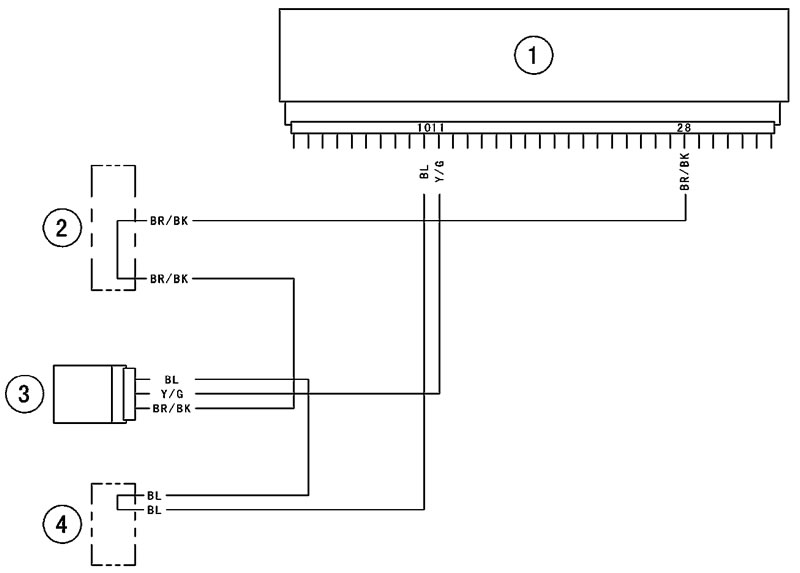Vehicle-down Sensor Removal
Caution: Never drop the vehicle-down sensor, especially on a hard surface. Such a shock to the sensor can damage it.
Remove:
- Bolts [A]
- Connector [B]
- Vehicle-down Sensor [C]
Vehicle-down Sensor Installation
- The UP mark [A] of the sensor should face upward.

Warning: Incorrect installation of the vehicle-down sensor could cause sudden loss of engine power. The rider could lose balance during certain riding situations like leaning over in a turn with the potential for an accident resulting in injury or death. Ensure that the vehicle-down sensor is held in place by the sensor brackets.

Vehicle-down Sensor Inspection
Note: Be sure the battery is fully charged.
- Connect a digital meter [A] to the connector [B] of the vehicle-down sensor [C] with the needle adapter set [D].
Special Tool - Needle Adapter Set: 57001-1457
Vehicle-down Sensor Power Source Voltage
Connections to Sensor Connector
- Meter (+) → BL lead [E]
- Meter (-) → BR/BK lead [F]
- Turn the ignition switch ON, and measure the power source voltage with the connector joined.
Input Voltage at Sensor
Standard: DC 4.75-5.25 V
- Turn the ignition switch OFF.
If the reading of input voltage is less than the standard, check the ECU for its ground, power supply and wiring.
If the power source is normal, check the output voltage.

- Remove the vehicle-down sensor (See Vehicle-down Sensor Removal).
Do not disconnect the sensor connector.
- Connect a digital meter [A] to the connector with needle adapter set [B].
Special Tool - Needle Adapter Set: 57001-1457
Vehicle-down Sensor Output Voltage
Connections to Sensor Connector
- Meter (+) → Y/G lead [E]
- Meter (-) → BR/BK lead [F]
- Hold the sensor vertically.
- Turn the ignition switch ON, and measure the output voltage with the connector joined.
Tilt the sensor 60-70° or more [C] right or left, then hold the sensor almost vertical with the arrow mark pointed up [D], and measure the output voltage.
Output Voltage at Sensor
Standard: with sensor tilted 60-70° or more right or left: 0.65-1.35 V with sensor arrow mark pointed up: 3.55-4.45 V

Note: If you need to test again, turn the ignition switch OFF, and then ON.
- Turn the ignition switch OFF.
If the output voltage is normal, check the wiring.
If the wiring is good, check the ECU for its ground and power supply (See ECU Power Supply Inspection).
If the ground and power supply are good, replace the ECU (See ECU Removal/Installation).
If the output voltage is out of the specified, replace the vehicle-down sensor.
Vehicle-down Sensor Circuit

1. ECU; 2. Water-proof Joint E; 3. Vehicle-down Sensor; 4. Water-proof Joint D
